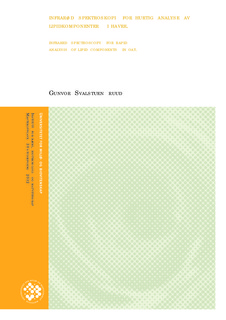Infrarød spektroskopi for hurtig estimering av lipidkomponenter i havre
Master thesis
Permanent lenke
http://hdl.handle.net/11250/186442Utgivelsesdato
2012-08-06Metadata
Vis full innførselSamlinger
- Master's theses (KBM) [890]
Sammendrag
Havre (Avenia Sativa) har mange interessante ernæringsmessige egenskaper og har blant annet det høyeste lipidinnholdet av kornartene. Majoriteten av lipidene er sunne en‐ og
flerumettede fettsyrer som oljesyre, linolsyre og α‐linolensyre. Denne oppgaven var et samarbeid med en aktør i havreindustrien som jobber med forskning og utvikling av nye havresorter med bedret ernæringsmessig kvalitet. Fettsyresammensetningen i havre
analyseres i hovedsak med gasskromatografi som er en tidkrevende metode. Formålet med denne masteroppgaven var å utvikle en metode for å estimere fettinnhold og
fettsyresammensetning i havre basert på infrarød spektroskopi av små mengder
prøvemateriale. I metodeutviklingen ble det undersøkt om målinger av havre med FT‐IR spektroskopi var reproduserbart. Det ble laget et forsøksdesign der 168 prøver med havremel ble blandet med ulike oljer og analysert med FT‐IR‐spektroskopi. FT‐IR spektrene ble korrelert mot
referanseanalysene relatert til fettinnhold og fettsyresammensetning i en prøvekalibreringen som fungerte bra med gode R2 verdier. Med informasjon fra forsøksdesignet og prøvekalibreringen ble det laget et nytt design og ny kalibreringsmodell. Det ble laget 63
prøver fra tre havremeltyper blandet med oljer slik at fettinnholdet og
fettsyresammensetningen ble variert på samme måte. Kalibreringen med regresjonsanalyse gav gode modeller, men litt lavere R2 verdier enn prøvekalibreringen. Prøvevolumene ble
mindre fordi det var lite prøvemateriale, noe som kan ha vært årsaken til mindre god
prøveopparbeidelse og kalibrering.
Kalibreringsmodellen ble test‐sett validert med 6 ukjente havremelprøver. Resultatene viste at oppbyggingen av designene fungerer og predikeringen av jodverdiene er god, men kalibreringen har et forbedringspotensiale og må utvikles videre for å kunne estimere fettinnhold og detaljert fettsyresammensetning. Dersom kalibreringen utvikles til å bli mer
nøyaktig kan det bli mulig å benytte FT‐IR spektroskopi industrielt til screening av
havreprøver i nær fremtid da metoden er ikke‐destruktiv, krever lite kjemikalier, er enkel i bruk og gir raske reproduserbare resultater. Oat (Avenia Sativa) has many interesting nutritional qualities and has among others the highest amount of lipids of the cereals. The majority of the lipids are healthy mono‐ and polyunsaturated fatty acids like oleic acid, linoleic acid and α‐linolenic acid. This study was a
collaboration with a company in the oatindustry who works with research and development of new types of oat with improved nutritional qualities. Fatty acids in oat are usually identified by gas chromatography, which is a time consuming method. The purpose of this
thesis was to develop a method to estimate the fat content and fatty acid composition in oat based on infrared spectroscopy with small amounts of sample. In the method development it was tested if the analysis of oat with FT‐IR spectroscopy was reproducible. A test‐design was made with 168 samples of oatflour mixed with different oils and analysed with FT‐IR spectroscopy. The results showed that the testcalibration with the FT‐IR spectres correlated with the reference analyses fat content and fatty acid composition
functioned very well with good R2 values. With information from the testing it was made a new design and calibration. It was made 63 samples of oatflour mixed with oils in the same way with variety of fat content and fatty acids as the testing. The calibration functioned well with good R2 values, but the R2 values was a bit less good than in the testing. The reason
for this could be the small amounts of the 3 different kinds of oatflour available, so the
samples therefore had to be in small volume which made it difficult and less accurate. The calibration model was test set validated by 6 unknown oatfloursamples. The results showed that the layout of the designs and the prediction of iodinvalues worked very well. The calibration model has an improvement potential and has to be developed to be able to predict fat content and detailed fatty acid content. If the calibration model is developed to be more accurate it would be possible to use FT‐IR spectroscopy in the oat industry in nearby future since the method is non‐destructive, requires little chemicals, is simple to use and gives rapid and reproducible results.
